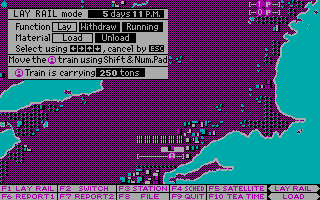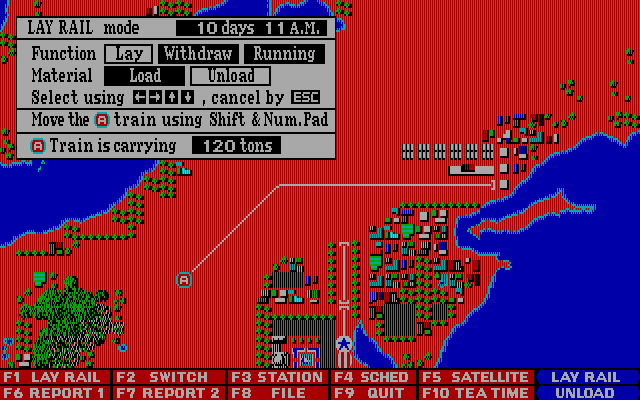Retro Replay Review
Gameplay
Railroad Empire places you in the conductor’s seat of a budding railroad tycoon, challenging you to construct and manage a transcontinental rail network under tight constraints. From the outset, you must survey terrain, carve out track routes around rivers and mountains, and deploy a limited supply of rails with surgical precision. The single-track design introduces an extra layer of tension—one wrong scheduling decision and trains can collide, forcing you to constantly monitor traffic patterns and switch operations.
The main gameplay loop revolves around the iconic A-Train, which you control directly as it lays tracks one segment at a time. Daylight hours are dedicated to track-laying and network expansion, while the accelerated night cycle allows for timetable adjustments and switch settings. This separation of duties keeps the action focused: by day you’re a civil engineer charting new lines, and by night you’re a dispatcher fine-tuning the flow of passengers and materials.
Optional cargo trains provide a clever resource-distribution mechanic, ferrying rails and construction materials from supply points to the ends of your expanding line. Balancing passenger revenue against the cost of track-building leads to engaging decisions: should you expand quickly to unlock new regions, or consolidate income in well-established corridors? With goal-oriented scenarios—linking New York to California or England to Turkey—each map feels like a self-contained puzzle, rewarding careful planning and adaptability.
Graphics
From a visual standpoint, Railroad Empire leans into crisp, isometric 2D art that emphasizes clarity and function over flash. The map tiles are easy to read at a glance, with distinct colors for terrain types—plains, hills, rivers—and clear icons for stations, bridges, and track segments. While it may lack modern shader effects, the interface is thoughtfully laid out, placing essential controls within quick reach so you can build and switch tracks without hunting through menus.
Train animations are simple but satisfying: locomotives chug along laid rails, their tiny carriages following obediently in tow. Watching your network come to life, with diesel engines puffing across a sprawling grid of steel, evokes a sense of nostalgia for classic tycoon sims. The day/night cycle is represented with subtle shading across the map, reinforcing the strategic division between construction hours and nighttime scheduling without pulling you out of the action.
The game’s UI panels—displaying track stock, construction costs, and train schedules—are clean and logically organized. Though some icons and text can appear small on high-resolution displays, tooltips fill in any gaps by providing clear descriptions. Veterans of early ’90s management sims will appreciate the no-nonsense design, while newcomers will find it straightforward enough to pick up after a short tutorial.
Story
Railroad Empire does not present a traditional narrative but instead unfolds its “story” through historical context and emergent gameplay. Rooted in the legacy of Artdink’s original Take the A-Train series—and the 1989 release of Railroad Empire by Seika Corp.—the game invites you to reenact the grand expansion of railroads across continents. Each map scenario evokes the era of industrial growth, with region-specific obstacles that frame your ambition as a logistical pioneer.
Rather than scripted characters or cutscenes, the drama emerges from your own progress: the moment you bridge a long river, complete a mountain pass, or finally synchronize a complex junction without collisions. The quiet satisfaction of seeing passenger numbers climb and revenue tick upward becomes the narrative payoff. Optional newspaper headlines and briefings add period flavor, celebrating milestones like “First Transcontinental Link Achieved” or warning of impending budget shortfalls.
While purists seeking a character-driven saga may find the story light, the historical backdrop and scenario objectives supply enough thematic grounding to keep the experience engaging. You are the architect of rail history, and your successes—and setbacks—form the chapters of your personal railroad epic.
Overall Experience
Railroad Empire offers a focused, strategic simulation that balances accessibility with depth. The straightforward building mechanics and real-time day/night cycle give the game a unique rhythm: track-laying by day, dispatch planning by night. This structure prevents the midgame lull common to many management titles, as you’re always pivoting between construction and operations.
The learning curve is gentle yet rewarding. Early scenarios guide you through basic track-laying and scheduling, while later maps introduce trickier terrain, tighter budgets, and more ambitious distance goals. The optional cargo trains and resource constraints inject fresh challenges without overwhelming newcomers. Meanwhile, veteran sim fans will appreciate the nod to Artdink’s classic designs and the tactical nuance of rail-only transport.
As a piece of gaming history repackaged for modern audiences, Railroad Empire delivers an engaging experience for anyone fascinated by industrial logistics and model-railroad aesthetics. Its minimalist presentation keeps you focused on strategy, and the satisfaction of witnessing your rail network stretch from coast to coast is timeless. Whether you’re a rail enthusiast or simply a fan of well-crafted simulations, this title stands as a testament to the enduring appeal of track-building tycoons.
 Retro Replay Retro Replay gaming reviews, news, emulation, geek stuff and more!
Retro Replay Retro Replay gaming reviews, news, emulation, geek stuff and more!









Reviews
There are no reviews yet.